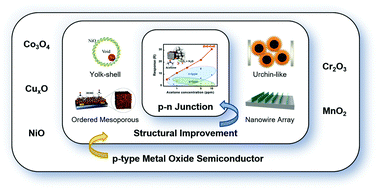Nanoparticle design and assembly for p-type metal oxide gas sensors
Abstract
Metal oxide semiconductors have wide band gaps with tailorable electrical properties and high stability, suitable for chemiresistive gas sensors. p-Type oxide semiconductors generally have less sensitivity than their n-type counterparts but provide unique functionality with low humidity dependence. Among various approaches to enhance the p-type characteristics, nanostructuring of active materials is essential to exhibit high sensing performances comparable to n-type materials. Moreover, p–n heterojunction formation can achieve superior sensitivity at low operating temperatures. The representative examples are hollow and urchin-like particles, mesoporous structures, and nanowire networks. These morphologies can generate abundant active surface sites with a high surface area and induce rapid gas diffusion and facile charge transport. For growing interests in environmental and healthcare monitoring, p-type oxide semiconductors and their heterojunctions with well-designed nanostructures gain much attention as advanced gas sensing materials for practical applications. In addition to precise nanostructure design, the combination with other strategies, e.g. light activation and multiple gas sensing analysis using sensor arrays will be able to fabricate the desired gas sensors with exclusive gas detection at ultra-low concentrations operating even at room temperature.

- This article is part of the themed collection: Recent Review Articles


 Please wait while we load your content...
Please wait while we load your content...